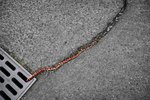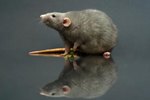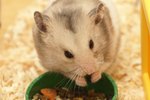
One of the most fun aspects of reptile husbandry is the creativity pet owners can express in the process. Some keepers like to construct custom cages, while others enjoy designing naturalistic terrariums, complete with real wood decorations. Unfortunately, some types of wood may be harmful to your pet reptile and must be avoided for their long-term health.
Cedar
Cedar has long been used in closets because it's naturally resistant to insects and decay. Unfortunately, cedar is one of the most dangerous woods for reptiles and should not be used in their care at all. Several species are known to be particularly dangerous, including white cedar (Thuja occindentalis), Japanese cedar (Cryptomeria japonica) and western red cedar (Thuja plicata); unfortunately, commercial products seldom make it clear which species has been used. Cedar is often used as substrate for small pet mammals and birds, though it is contraindicated for many of these species as well. Reptiles exposed to cedar may exhibit respiratory symptoms or develop skin lesions.
Pine and Eucalyptus Trees
Pine trees and eucalyptus trees are similar to cedar trees, and produce aromatic phenols. Though there isn’t as much evidence linking pine and eucalyptus to health problems as there is for cedar, their use is discouraged. Products made from the bark of the trees is not as aromatic as the wood is, and is likely safer.
Chemically Treated Wood
A variety of different chemicals may be used to treat wood based on its intended use. Wood destined for construction is often treated with chemicals to increase its resistance to decay; some of these chemicals can leach out of the wood or disperse through the air. Additionally, some tree branches -- particularly those of fruit trees -- may have been sprayed with pesticides. Do not use wood in reptile habitats if it has been contaminated by pesticides, herbicides or wood preservatives.
Wood with Thorns
Honey locust (Gleditsia triacanthos ) and hawthorne (Crataegus sp.) trees are noted for their long, sharp thorns and should not be used in reptile caging. Additionally, it's important to avoid using branches with sharp edges or holes that may trap your pet. Generally speaking, use common sense and inspect any branches used in a cage for potential dangers.
Safe Woods
Shredded aspen can be used safely as a long-term substrate, as can cypress mulch and orchid bark. Any branches or wood collected outside must be sterilized before being used in the habitat. Do this by baking the wood in an oven at 250 degrees for at least 30 minutes. Provided they haven’t been exposed to chemicals; oak (Quercus sp.), dogwood (Cornus floridana), tuliptree (Liriodendron tulipifera), maple (Acer sp.) and crepe myrtle (Lagerstroemia sp.) branches are popular and safe choices for providing climbing opportunities and decoration.
References
- Melissa Kaplan's Herp Care Collection: Use of Cedar as a Substrate for Reptiles and Other Pets
- Melissa Kaplan's Herp Care Collection: More on the Use of Pine in Captive Habitats
- University of North Carolina, Chapel Hill: Respiratory Toxicity of Cedar and Pine Wood: A Review of the Biomedical Literature From 1986 Through 1995
- Doctors Foster and Smith: Substrate Dos & Don'ts for Reptiles: Selecting a Safe Substrate
- Caudata Culture: Wood for use in Vivarium
- Petco: Dangerous Chemicals
- Vida Preciosa International: The Ball Python Care Sheet
Photo Credits
-
Photos.com/Photos.com/Getty Images




